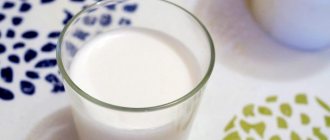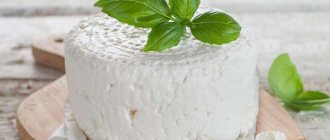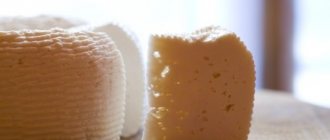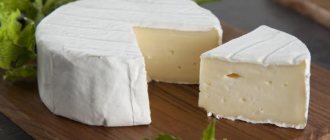Sour milk can be used not only for baking.
It makes wonderful cheese.
Moreover, there are a huge number of recipes for its preparation.
Let's not let good things go to waste?
Sour milk cheese - general principles of preparation
For cheese, you can simply use sour milk or shriveled yogurt. The final products will differ from each other, but only slightly. Salt, eggs, sour cream, cottage cheese, and butter are usually added to milk. Sometimes soda, lemon juice, vinegar and other ingredients are added to speed up the separation of whey or cause the product to melt.
All cheeses made from sour milk must be expressed. To do this, use several layers of gauze. The prepared mass is poured into it and left for a while. If the recipe requires it, then oppression is applied. The weight makes the cheese denser, not like cottage cheese.
How to make fermented milk cheese with sour cream
To make milk cheese with sour cream at home with your own hands, you need a minimum of inexpensive ingredients and 3 hours of time. With sour cream, tender cheese made from sour milk will turn out even more delicious, it will acquire an interesting creamy shade and will turn out fattier than usual.
There is little salt in the product, so if you are not a fan of salty foods, then this recipe is just for you.
Ingredients
- Sour cream – 4 tbsp;
- Sour milk (or curdled milk) – 1 l;
- Dill greens - to taste;
- Eggs – 4 pcs.;
- Lemon juice – 1 tsp;
- Salt – 0.5 tsp.
Making cheese from sour milk with sour cream
- Heat the sour milk with added lemon juice over medium heat.
- Beat eggs, sour cream and salt in a deep bowl with a mixer.
- Pour the resulting egg-sour cream mixture into warm milk and continue to bring it to a boil. After boiling, cook the sour milk over low heat for 20-25 minutes.
- Finely chop the greens and add them to the boiling milk mixture.
- After 20 minutes of cooking, the whey will separate from the curd mass. Then the cheese can be transferred to a colander lined with gauze, wrapped the product and placed under pressure on top of it (first place a plate or saucer, and then a full can of water). The serum will drain within 2 hours.
- Subsequently, we take the cheese out of the gauze and put it in the refrigerator for a while (about 12 hours) so that it cools a little and brews (ripened).
The taste of this cheese is very similar to the well-known and beloved suluguni cheese, only our homemade version is much tastier and healthier than the store-bought counterpart.
The finished fermented milk product can be served as an independent dish, or as an auxiliary ingredient for preparing salads, sandwiches, pizza, pastries and all kinds of main courses.
Despite the simplicity of making milk cheese, sometimes housewives have unpleasant moments during the cheesemaking process. To prevent them from affecting the final result, we offer simple recommendations to help you improve the taste and quality of homemade cheese.
To make delicious homemade cheese, we need undiluted village milk with a high percentage of fat content. As a rule, they use sour cow's milk, but if you prefer goat's milk, you can use that too.
Cheese made from goat's milk will taste more like feta cheese.
If you are not in a hurry, then there is no need to add anything; let the process of separating the whey from the curd occur naturally.
But if time is tight for you, you can speed up the preparation by adding vinegar, soda or (best of all) lemon juice to the curdled mass. They will provoke an accelerated separation of the serum, and you will not have to wait up to half an hour.
This is a prerequisite for all cheeses made with sour milk. The process of straining is simple and does not differ much from traditional straining: we line a colander with several layers of gauze, put cottage cheese and whey in it and give the semi-finished mass time to get rid of excess moisture.
If you like soft cheeses, then you don’t have to use oppression. To make the dairy product hard, you need to put a jar of water in it for several hours. Subsequently, the cheese can also be put in the refrigerator so that it dries out slightly and finally thickens.
To give homemade cheese a special taste, you can add any herbs (dill, parsley, celery) and your favorite spices (basil, herbs de Provence, oregano, etc.). But this stage is not obligatory, you decide for yourself how it tastes better to you - with or without additives.
That's probably all you need to know about how to make cheese from sour milk at home. Simple technology and a minimum of physical effort in exchange for a healthy, nutritious product (100 g of fresh cheese contains about 300 kcal) with an unusually delicate taste - what more could a housewife wish for?
Sour milk can be used not only for baking.
It makes wonderful cheese.
Moreover, there are a huge number of recipes for its preparation.
Let's not let good things go to waste?
Sour milk cheese with egg
A simple recipe for sour milk cheese at home. A great way to identify unclaimed sour milk.
Ingredients
• 1 liter of milk;
• salt;
• egg.
Preparation
1. Break an egg into a bowl, add a pinch of salt, and beat with a fork.
2. Combine the egg and sour milk, stir, pour into a saucepan.
3. Place the mixture on the stove and start heating. Stir, don’t go far.
4. As soon as the egg and milk begin to coagulate into flakes and the whey has separated, remove the pan from the heat. Let it sit for half an hour.
5. Line a colander with 4 layers of gauze and pour the mixture.
6. Raise the edges up and express the serum.
7. Place pressure on the cheese and leave for two hours. The longer the cheese lies under pressure, the harder and drier it will be.
Step-by-step recipe with photos
I put the so-called “milk” on the fire, added salt and started stirring until the whey appears. Then I added the egg and began to cook, stirring as well, but not boiling. After about two minutes, I threw the mixture into a colander with 2 layers of gauze, and while the whey was hot, I used it for pancakes. When the mass was completely glass, put it into a suitable deep container, covered it with a saucer and put the press in the refrigerator for 3 hours.
Well, after that I prepared a delicious salad!!!)
General rules
The basic rule for making cheese from sour milk is that it should not be pasteurized, otherwise it will not sour, and if it sours, it will be bitter.
- To make cheese, it is better to buy farm cow's milk with a high percentage of fat content; it turns sour on the second day if left in an open jar at room temperature.
- If you prefer goat's milk, then you can use that. The cheese, in this case, will look like feta cheese.
- The taste and quality of cheese are directly dependent on milk. There is no need to use low-calorie products for production. The cheese will come out tasteless, dry, and the yield will be small.
- You can speed up the process of milk souring with the help of lemon juice, apple cider vinegar, grape vinegar, by adding these components, when heated, the souring procedure will go many times faster.
- If the recipe contains lemon juice, you can replace it and make it with citric acid.
- Sour milk is prone to burning; to prevent this from happening, we use an aluminum or non-stick pan, and the contents must be stirred all the time while heating.
Maturing and storing cheese
In total, preparing young cheese from sour milk may require 3 hours of free time. The curd mass, suspended in gauze over the pan, should be kept in a cool place for at least two hours. The cheese obtained as a result of this manipulation will be quite loose. To make it crumble less when cutting, you need to put it in the refrigerator for at least 1 hour. If you keep it at low temperatures longer, it will begin to harden.
Cheese made from sour milk should be stored in the refrigerator for 7 to 10 days. It is recommended to wrap it in cling film or place it in brine. It keeps well open on a plate.
Labneh recipe or how to make yogurt cheese at home
- 500 g Greek yogurt;
- ½ teaspoon salt;
- ½ teaspoon garlic powder;
- mint;
- onion;
- 1 sprig of rosemary;
- 1 bay leaf;
- 6 or 7 peppers;
- dry chili;
- extra virgin olive oil.
Instructions.
- Place 2 layers of thin cloth or cheesecloth in a colander and place it on top of the top bowl so that it does not touch the whey that will be released.
- Mix yogurt with salt and garlic powder and pour it into a cloth prepared over the filter.
- Tie the cloth and let it hang in the refrigerator for 24 hours, making sure the yogurt does not touch the whey.
- Add onion, rosemary, bay leaf, pepper, chili pepper to a glass jar and fill half with oil.
- Form balls and place them in a jar with oil and herbs.
- Just cover them with more oil if necessary and leave to marinate for two days in the refrigerator.
List of ingredients
The simplest recipe for sour milk cheese consists of using the following products during the preparation process:
- sour milk - 3 l;
- egg - 3 pcs.;
- salt - 2 tbsp. l.;
- apple cider vinegar - 3 tbsp. l.
The above quantities of ingredients should yield 400-450 g of cheese and about 1.5 liters of whey. It can be used when kneading dough for bread or pancakes. You can cook less cheese. But it is advisable to start the cooking process when there is at least 1 liter of sour milk available.
The calorie content of 100 g of such cheese is approximately 113 kcal or more. The final result depends on the fat content of the milk.
Homemade Philadelphia cheese
Philadelphia cheese is a dish of European cuisine. It appeared back in 1872. The first time it was prepared in America.
The delicacy is made from kefir, which can be replaced with homemade sour milk. It is noteworthy that housewives can easily make Philadelphia in their kitchen.
Main ingredients:
- homemade kefir – 500 ml;
- cow's milk - 1 liter;
- lemon juice – 1 teaspoon;
- kitchen salt – 1 teaspoon;
- chicken eggs – 1 pc.
Step by step process:
- Add salt to the full-fat milk and heat until the first bubbles appear.
- Remove from heat. Immediately pour homemade kefir into it and stir quickly until everything curdles. This lasts about 4-5 minutes.
- Strain into a bowl with a sieve, into which you place four layers of gauze. Do not squeeze. Gather the gauze into a knot. Hang over the pan. Leave for twenty minutes.
- Squeeze lemon juice into a small bowl.
- Using a mixer, beat the eggs until thick foam, adding juice.
- Add egg foam to the resulting curd and beat with a mixer at high speed. The mass should be very airy.
- Place in the refrigerator or on the balcony overnight.
Philadelphia is a creamy, delicate cheese. It has a slightly sour milky taste and is a healthy product. Cheese is needed by the human body who has a lack of calcium in the body, as it consists of natural dairy components.
Varazdat Yeganyan, owner and chief technologist of the company Artisan Cheese Factory
“In France, there are cheeses that are made only from raw milk, and there are those that are made from both raw and pasteurized milk. The French say that if you make the first cheeses from pasteurized milk, they will not only have a different taste, but they will simply not work out. This mainly applies to hard cheeses - their quality depends more on the raw materials. It’s easier with soft cheeses: they don’t need to be aged for a long time - and the processes occurring in the milk affect them to a lesser extent. By the way, in Russia no one really makes hard cheeses; we can say that they don’t exist: perhaps precisely because it is impossible to get good hard cheese from pasteurized milk. You'll end up with a piece of plastic, not cheese.
It is very difficult to provide your production with guaranteed safe raw milk; it is easier to cook from pasteurized milk. When we pasteurize milk, we kill most of the bacteria. To ensure that the cheese still has flavor, we artificially add a starter culture, which consists of various bacteria. But in any case, we cannot restore the original bacterial background of milk. Therefore, pasteurization, of course, affects the taste. The second point is that during pasteurization the amount of protein in milk decreases. And protein is the basis of cheese. There is a minimum standard for protein content in milk suitable for cheese making, if I'm not mistaken, it is 3.2%. In our country, the amount of protein in the bulk of milk does not even reach 3%, and during the pasteurization process it decreases by several tenths of a percent. To restore the protein content, large enterprises in Russia, and throughout the world, add calcium chloride. You can't go anywhere without this. Nowhere is perfect milk available in such huge quantities to satisfy mass production.
READ ALSO: Effective means for active growth of cabbage
It is impossible to unequivocally answer the question whether it is possible to make cheeses from raw milk in Russia. Since the 1930s, there has been a ban on the use of raw milk in cheese making in the USSR. An exception was made only for shepherds living in the mountains, because in the heat it was not possible to bring milk down from the mountains for pasteurization. Now this ban continues to apply, but new exceptions are appearing. The Minister of Agriculture was asked whether it was possible, and he answered: “Make your own specifications and cook.” Formally, in our country it is possible to produce products either in accordance with GOST standards, or in accordance with technical conditions developed independently and approved by Rospotrebnadzor. I know of only one cheese factory in Lipetsk that managed to approve its technical conditions, so that they can officially brew cheeses from raw milk. They have their own herd, their own raw materials. But! They make hard cheeses. The bulk of pathogens present in the protein die 2 months after the start of the cheese ripening process, which makes such cheese safe. What remains is the result of the vital activity of bacteria, and the taste of the cheese depends on this.
I'm experimenting. Now I’ve put cheese made from raw milk into maturation, I’ll see at the end of the year what comes of it. But, alas, I won’t be able to make this kind of cheese for sale - it’s as if it’s officially impossible to sell them. But some cheesemakers sell with warnings that their cheese is made from raw milk. In general, our law allows for different interpretations.”











